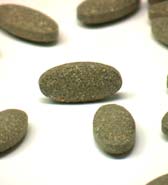
I strongly recommend this herbal hairloss product to anyone who has or who is experiencing hair loss regardless of gender.”
~L.D. Stephens
Root of Beautiful Hair: Plant a Garden
To brighten blond hair or make brunettes look shiny, the sources of nearly all hair-care products were plants. If you're looking for a more natural path to beautiful hair, plant a garden and harvest what you need to look your very best without spending very much at all.
Maybe you think that all tea is for drinking. Strongly steeped teas made of fresh herbs were valuable hair rinses. They cut the tallow soap residue down with natural oils that left newly washed tresses light and bouncy. Rosemary was the most favored herb for brown hair and is still found in some hair-care products. It is said to help hair remain curled even in damp weather. Pour a pint of boiling water over a cup of freshly chopped leaves. Allow it to stand until cold. Then bottle it and rinse hair after washing.
For darkening lighter shades of brown hair or dealing with gray, garden sage was used. Create a rinse by steeping a half-cup of freshly chopped sage in a quart of boiling water for 20 minutes. The longer it is boiled the darker the rinse will be. Strain liquid and pour over hair. Allow it to remain for 15 minutes, then rinse with clear water.
In the same way, American pioneer women steeped hulls, not the nut of black walnut, for a very effective darkening rinse. It was effective at toning down gray and should be treated as a real hair dye. Hulls of walnut, pecan and shagbark hickory are old-time natural dyestuffs used for centuries to color yarn, cloth, leather and baskets.
To bring the natural highlights back into blond hair, use chamomile. Add four tablespoons of dried flowers to a pint of water in a saucepan. Boil for a half-hour. Allow to cool and strain off flowers to yield the rinse. After washing your hair, wring it out and apply the rinse, allowing it to remain on the hair as you dry it the usual way.
Blond hair was greatly admired in ancient Rome. Women brought out golden highlights by using mullein flowers. Later, in the Middle Ages, the same marigold petals once used to color cheddar cheese were used to create a hair-tinting rinse.
Native Americans of the Southwest used yucca to wash their hair. The large roots of this plant contain gentle saponifiers that cleanse the hair without damage or residue. Roots were dug up, chopped finely and steeped in water for a half hour. Suds are worked up by rubbing the roots to create a thick lather. Remove the roots and apply lather to the hair. Even after modern soaps were available, many tribal groups preferred yucca for its gentle cleansing that did not strip or dry the hair.
Keep in mind that only the wealthy could afford prepared cosmetics, which fueled a cottage industry of natural herbal cosmetics. Ask yourself: Would I rather go out in the garden and pick rosemary? Or is it easier to drive to the supermarket, find a parking place, hunt down the product, wait in line, spend the money and fight traffic all the way home?
By Maureen Gilmer, Scripps Howard News Service